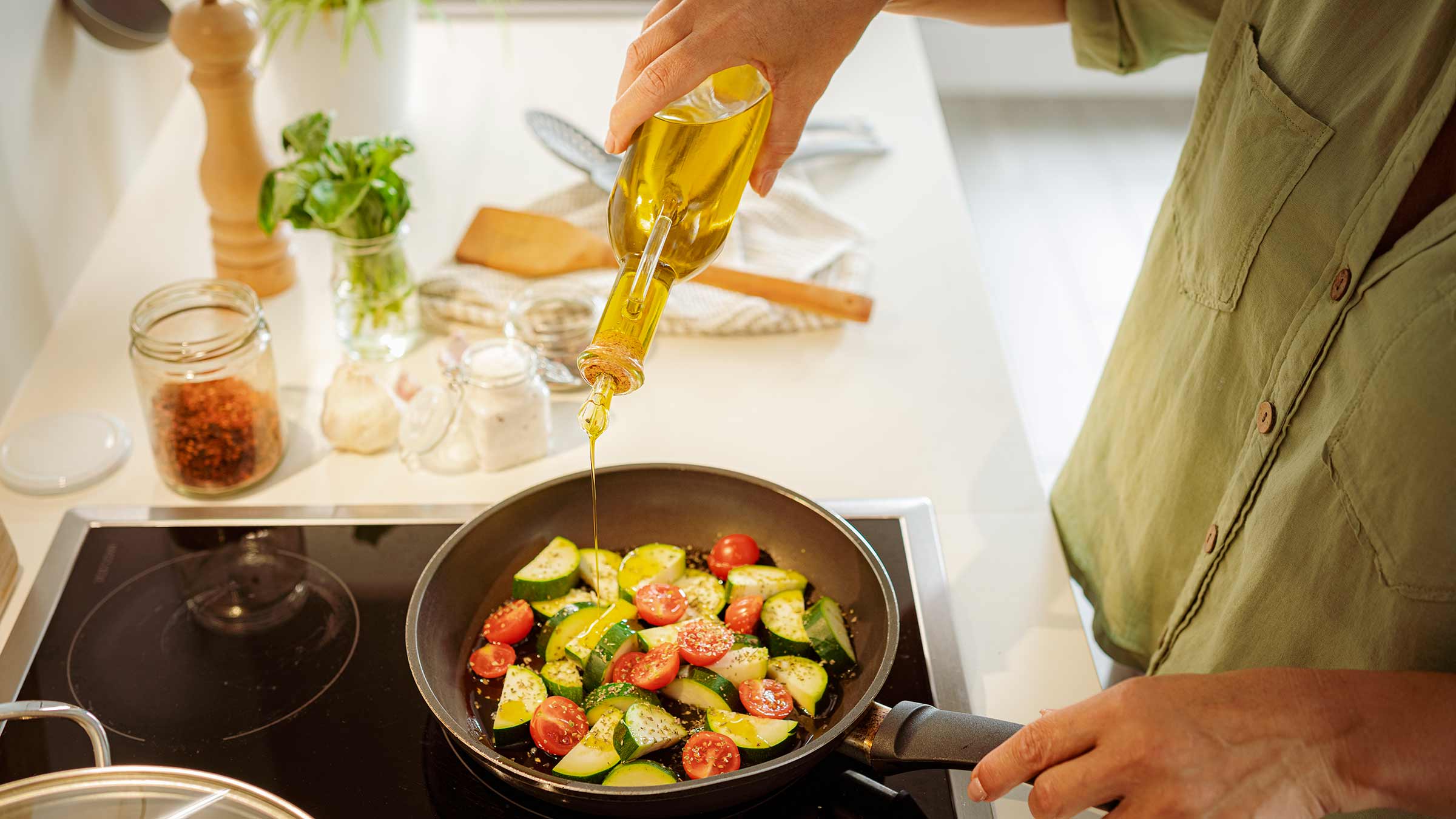
The Mediterranean diet is a good example of how Americans should be eating, not far from what’s recommended in current Dietary Guidelines for Americans from the U.S. Department of Agriculture. Let’s walk through some of the easiest ways to adopt this flexible eating pattern.
What is the Mediterranean diet?
The Mediterranean diet is based on the traditional eating habits of people native to areas along the shores of the Mediterranean Sea. Many people think immediately of Greece and Italy, but it also includes several countries in southern Europe, western Asia and northern Africa.
The Mediterranean diet is an overall healthy eating pattern or blueprint for eating and doesn’t involve exact rules. It looks at the eating pattern as a whole.
Hallmarks of the Mediterranean diet:
- Lots of fruits and vegetables
- Whole grains
- Nuts and seeds
- Beans and other legumes, like lentils and peas
- Some meats, mostly fish and poultry
- Olive oil
- Herbs and spices
How strict is the Mediterranean diet? What foods are restricted?
It's not extremely strict, which has made it popular. It can be used by vegetarians, vegans, people with food sensitivities and those seeking to follow a sustainable plant-based diet plan.
It does frown on some things that many Americans eat every day, including highly processed snack foods. It limits sugar. It's also lower in red meat and other foods that contain saturated fat than the typical American diet.
What are the health benefits of the Mediterranean diet?
There's a very clear link between diet and disease, and we do know this diet is different from the typical American diet in a few ways:
- It’s higher in phytonutrients and other compounds that come from plants.
- It’s higher in fiber.
- It’s lower in saturated fat.
These types of eating habits are linked to a lower risk of:
- Heart disease and high cholesterol
- Type 2 diabetes
- Some cancers
- Neurological diseases
- Overweight and obesity
Is it important to use olive oil as part of the Mediterranean diet?
The Mediterranean emphasizes olive oil because it’s low in saturated fat. This is in line with the overall diet being low in saturated fat, with limited red meat and butter and other dairy products. That lower saturated fat content plays a role in helping to lower cholesterol and other factors that can lead to heart disease. Olive oil also is high in polyphenols, plant compounds linked to a lower risk of breast cancer.
Does the Mediterranean diet include red wine?
The diet generally includes red wine — in moderation. There have been some benefits linked to moderate wine consumption. However, there's quite a bit of growing research showing negative effects of drinking any type of alcohol.
Our recommendation:
If you don't drink, don't start.
If you do decide to drink, drink in moderation, and pick red wine over liquor, for example. “Moderation” means one drink or less per day for women and two drinks or less per day for men.
What can I do to get started on the Mediterranean diet?
It's really more of a lifestyle change. Meeting with a dietitian can help. I recommend that you consider what you're eating day in and day out and start with small changes, then build from there. Some things to think about to get started:
Where can you start fitting in more fruits and vegetables? Can you add a fruit or a vegetable to most meals? Can you swap out a bowl of ice cream or other sugary snack for a bowl of fruit a few nights a week?
Take a look at the ingredients in your grains. Are you eating 100% whole grain bread? Are you eating whole grain rice (not white refined) rice and whole grain pastas? Try to switch over.
Try to include more beans, peas and lentils overall. Try to add beans to salads or mix them in pasta dishes or other dishes. Try lentil soup
Replace red meat with poultry, fish, beans, peas or lentils. Start by swapping one meat dish a week with a fish dish, for example.
Replace butter and other oils with olive oil.
Can people who follow a gluten-free diet use the Mediterranean diet?
Most of the menu of the Mediterranean diet is naturally gluten free, including produce, fish, poultry, beans, legumes, rice and potatoes. There also are quite a few gluten-free grains. It may be easier to follow a gluten-free diet if you're following the Mediterranean diet than if you’re following a standard American diet, because you’re likely eating fewer processed foods out of a box or package, with less room for contamination.
Is the Mediterranean diet anti-inflammatory?
The Mediterranean diet is at the top of the list of anti-inflammatory diets, which are beneficial to everyone, and especially to people who have inflammatory conditions, such as high blood sugar or rheumatoid arthritis, for example. It’s anti-inflammatory because it's largely plant-based and because the many herbs and spices used in the diet have a strong anti-inflammatory effect.
Can I follow the Mediterranean diet on a budget?
Often fresh fruits and vegetables, fish and olive oil are more expensive foods, so you might need to get creative. Some ideas:
- Use at least a portion of olive oil by adding it with other oils.
- If you’re spending more on oil, try to balance it by replacing some meat with beans or legumes.
- Buy frozen or canned fruits and vegetables instead of fresh.
- Buy canned tuna.
Sample Mediterranean One-Day Diet
Breakfast
- 1 cup lower sugar or plain low-fat Greek yogurt with:
- ½ cup fresh or frozen berries or other fruit
- 2 tablespoons chopped nuts, like walnuts
- Avocado toast: 1 slice whole wheat bread with ¼ mashed avocado, add herbs as desired
- Coffee or tea (limit or eliminate sugar and cream)
Lunch
- Large mixed-greens salad with:
- any chopped vegetables, like cucumbers, peppers, tomatoes, onions, etc.
- consider adding ½ cup any type of cooked or canned beans
- 1 tablespoon olive oil and 1 tablespoon any type vinegar, like balsamic
- chopped herbs, like rosemary, basil, etc.
- 3 ounces baked chicken breast or meat alternative, like tofu, if desired
- ½ large pita or whole small pita with 2 tablespoons hummus
- Fruit, like an apple, orange, pear or banana
- Water or plain iced tea
Dinner
- 4 ounces baked/broiled or grilled fish
- 1 cup cooked whole grain rice or other whole grain, like farro, barley, etc.
- 1 cup steamed vegetable, like broccoli, cauliflower or asparagus (Drizzle with 2 teaspoons olive oil and season with a pinch of salt and pepper)
- Plain or carbonated calorie-free water or plain decaf iced tea
- 2 cups diced melon
Snack ideas (one or two per day, if hungry between meals)
- Banana with 1 tablespoon any nut butter
- 1 low-fat mozzarella cheese stick and 1 cup fruit, like grapes, melon, orange slices, etc.
- 3 cups low-fat, lower sodium popcorn
- 1 ounce dark chocolate
- ¼ cup any type nuts, can add fruit
Nutrition information:
Calories: 1,760
Fat: 71 grams
Protein: 80 grams
Carbohydrates: 200 grams
Fiber: 30 grams
Sodium: 1,335 milligrams
Potassium: 3,455 milligrams

Healthy eating is within your reach!
Make an appointment with our dietitians or nutritionists.
Schedule an appointment




